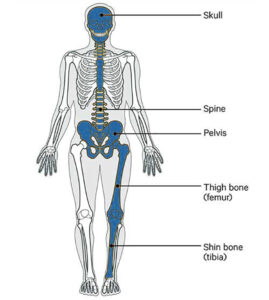With a characterization of disorganized bone remodeling, Paget’s disease is a bone disorder that can cause many complications within the body. The normal process of bones breaking down and then regrowing is affected by the presence of Paget’s disease. The usual process is abnormal with this disease, and it includes an excess of bones breaking down and regrowing.
Due to this, the bones end up being bigger and softer than usual. This alone highlights why it can be such a problem for affected individuals.
It can easily lead to fractured bones in addition to becoming mishappen.
One upside is that Paget’s either affects one bone or a few others in the body, and it doesn’t pose a concern for every bone in the body.
This article will provide detailed yet comprehensive insight into the disease, along with the known causes and treatments.
A Breakdown of Paget’s Disease
There’s quite a bit of science behind how this disease works. With enhanced bone resorption comes an increased osteoclast activity and the recruitment of osteoblasts.
This ends up resulting in the production of an excess of new bone matrix.
Interestingly, this occurrence doesn’t happen in a coordinated process, which means certain aspects of forming bone tissue become disorganized.
Another peculiar aspect of the disease is that many people who have it are asymptomatic. Regarding diagnosis, it requires medical professionals to use elevated serum alkaline phosphatase levels.
Another method is through characteristic radiographic findings.
Certain clinical manifestations associated with Paget’s disease include the following:
- Bone pain
- Enlarged skull
- Hearing loss
- Bowing of long bones
Many of these can be pretty painful for the patient and potentially exacerbate over time.
Thankfully, patients have multiple treatment options which aim to regulate bone remodeling and reduce bone turnover.
The full scope of treating the disease is to alleviate symptoms, reduce the risk of fractures, and prevent future complications.
Aside from the symptoms mentioned above, Paget’s disease can lead to a handful of adverse health conditions.
These aren’t necessarily a guarantee, but years of research have discerned their association with a wide variety of patients.
Other health concerns related to Paget’s disease include some of the following:
- Heart failure
- Loose teeth
- Loss of vision
- Kidney stones
- Arthritis
- Problems with the nervous system
This isn’t a disease that should be overlooked, as many of these symptoms can become worse with time. In less common circumstances, the disease can also lead to bone cancer.


A Look at Diagnosis
Although a proper diagnosis can be accomplished, many times, Paget’s disease is found by accident through various tests.
As mentioned earlier, many people with the disease are known to be asymptomatic, which can make it hard to look for.
Nevertheless, many common testing procedures for the disease can be found in the list below.
- X-rays of the affected bones
- Bone scans
- Medical history
- Physical exams
- Alkaline phosphatase blood tests
One or more of these medical tests can lead to the discovery of Paget’s disease, which will lead patients toward unique treatment plans based on their needs.
This article may make it seem like a step-by-step process, but the effects of Paget’s disease can come with many twists and turns. Every patient shows a range of similar and unique symptoms based on their circumstance.
There’s also a chance that some people may not be able to tolerate certain treatments, which means a little trial and error might be a part of the process.
Doctors will likely incorporate pain management strategies as well. Physical therapy and analgesics are common efforts toward relieving bone pain.
Treating Paget’s Disease
It’s common for long-term follow-ups to be a part of treating Paget’s disease. In circumstances of severe deformities and neurologic issues, surgical intervention may be a requirement. Every treatment decision must be tailored to the patient’s body, as the disease affects people in many unique ways.
Early detection is also a vital component of developing an effective treatment plan. This can help to improve outcomes of successful treatment and prevent further complications down the road.
Of course, medicines are also a solution, with the most common choice being bisphosphonates. Although many patients would prefer to avoid surgery, this isn’t always an option. Below are some of the courses of action related to surgical intervention.
- Replace joints in cases of severe arthritis
- Reducing pressure on specific nerves
- Fixing fractures to heal in a better position
- Work on deformed bones and realign them
It’s understandable that Paget’s disease sound especially uncomfortable, but that doesn’t mean patients will have to suffer with discomfort forever.
Even if most people would rather avoid surgical intervention, it’s the solution that offers the quickest and most effective benefits.
In Conclusion
This article highlights many key points about how Paget’s disease is managed and treated.
As unfortunate as it may be, plenty of medical expertise is available to help ward off the effects of the disease.
Not only that but many deformities found in the body can be fixed using a variety of surgical methods.
With a combination of medicine and surgery, many people make a significant recovery from Paget’s disease and live an extremely fulfilled life.










